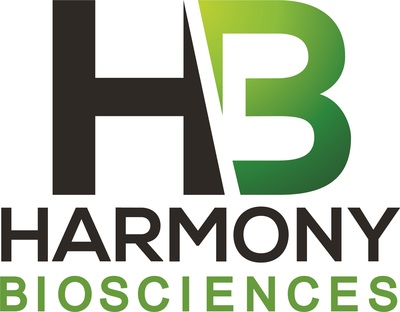HARMONY BIOSCIENCES ANNOUNCES POSITIVE TOPLINE DATA FROM PHASE 2 SIGNAL DETECTION STUDY EVALUATING PITOLISANT IN ADULT PATIENTS WITH MYOTONIC DYSTROPHY TYPE 1
- Clinically meaningful improvements in excessive daytime sleepiness and fatigue demonstrated
- Clear and consistent dose-response with higher dose pitolisant group showing a greater response
- No new safety signals detected, consistent with the established safety profile of pitolisant
- None.
Insights
Analyzing...
A clinically meaningful improvement was demonstrated on the primary efficacy endpoint, the change from baseline to the end of the double-blind period for excessive daytime sleepiness (EDS) as measured by the Daytime Sleepiness Scale (DSS). A clinically meaningful improvement was also demonstrated for fatigue, a secondary efficacy endpoint measured by the Fatigue Severity Scale (FSS). EDS and fatigue occur in up to 80
"These strong topline results add to the body of evidence supporting the effectiveness of pitolisant for improving EDS," said Jeffrey M. Dayno, M.D.,
Topline results include:
- Clinically meaningful improvements were demonstrated in EDS as measured by DSS, Epworth Sleepiness Scale (ESS), and Clinical Global Impression of Severity (CGI-S) of EDS.
On DSS, the mean change from baseline to end of double-blind period was
-2.5 and -1.0 for the higher dose and lower dose pitolisant treatment groups, respectively, compared to -0.2 for placebo.
On ESS, the mean change from baseline to end of double-blind period was
-4.88 for the higher dose pitolisant treatment group compared to -0.10 for placebo.
On CGI-S, the mean change from baseline to end of double-blind period was
-0.9 for the higher dose pitolisant treatment group compared to -0.1 for placebo.
- Clinically meaningful improvements were demonstrated for fatigue as measured by the Fatigue Severity Scale (FSS).
On FSS, the mean change from baseline to end of double-blind period was
-0.86 and -0.36 for the higher dose and lower dose pitolisant treatment groups, respectively, compared to -0.13 for placebo.
- A clear and consistent dose-response was demonstrated with the higher dose pitolisant group showing a greater response than the lower dose group across the study endpoints.
- Safety and tolerability profile in adult patients with DM1 was consistent with the established safety profile of pitolisant with no new safety signals detected and no serious adverse events reported.
"EDS is the most common non-muscular complaint in patients living with DM1, being present in the majority of patients," said Dr. Jean-Denis Brisson, Centre Intégré Universitaire De Santé Et De Services Sociaux du Saguenay-Lac-Saint-Jean. "The positive signals from this Phase 2 study are very encouraging, and support pitolisant as a potential treatment option for DM1."
This Phase 2 signal detection study was a randomized, double-blind, placebo-controlled study in adults ages 18-65 with DM1. This study was not powered to demonstrate statistical significance. Thirty patients were randomized at baseline to receive lower dose pitolisant, higher dose pitolisant, or placebo in a 1:1:1 treatment ratio titrated over three weeks, followed by eight weeks of stable dosing.
"These positive signals for pitolisant are promising news for the DM1 patient community, where 80-90 percent of the approximately 40,000 diagnosed DM1 patients in the
The full dataset from this trial will include findings from other secondary outcomes, including the Myotonic Dystrophy Health Index (MDHI), cognitive functions, and the safety and effectiveness of pitolisant from the ongoing Open-Label Extension (OLE) Phase. Additional results from the trial will be shared early next year. Detailed results will be presented at an upcoming medical meeting and will be submitted for publication.
Pitolisant is marketed as WAKIX® in the
About Myotonic Dystrophy Type 1
Myotonic dystrophy Type 1 (DM1) is the most common form of adult-onset muscular dystrophy. It is a genetic disorder inherited in an autosomal-dominant pattern. Latest estimates suggest a prevalence of about one per 2,100 people with the genetic defect for DM1. This equates to about 150,000 people in the
About WAKIX® (pitolisant) Tablets
WAKIX, a first-in-class medication, is approved by the
Indications and Usage
WAKIX is indicated for the treatment of excessive daytime sleepiness or cataplexy in adult patients with narcolepsy.
Important Safety Information
Contraindications
WAKIX is contraindicated in patients with known hypersensitivity to pitolisant or any component of the formulation. Anaphylaxis has been reported. WAKIX is also contraindicated in patients with severe hepatic impairment.
Warnings and Precautions
WAKIX prolongs the QT interval; avoid use of WAKIX in patients with known QT prolongation or in combination with other drugs known to prolong the QT interval. Avoid use in patients with a history of cardiac arrhythmias, as well as other circumstances that may increase the risk of the occurrence of torsade de pointes or sudden death, including symptomatic bradycardia, hypokalemia or hypomagnesemia, and the presence of congenital prolongation of the QT interval.
The risk of QT prolongation may be greater in patients with hepatic or renal impairment due to higher concentrations of pitolisant; monitor these patients for increased QTc. Dosage modification is recommended in patients with moderate hepatic impairment and moderate or severe renal impairment (see full prescribing information). WAKIX is not recommended in patients with end-stage renal disease (ESRD).
Adverse Reactions
In the placebo-controlled clinical trials conducted in patients with narcolepsy with or without cataplexy, the most common adverse reactions (≥
Drug Interactions
Concomitant administration of WAKIX with strong CYP2D6 inhibitors increases pitolisant exposure by 2.2-fold. Reduce the dose of WAKIX by half.
Concomitant use of WAKIX with strong CYP3A4 inducers decreases exposure of pitolisant by
H1 receptor antagonists that cross the blood-brain barrier may reduce the effectiveness of WAKIX. Patients should avoid centrally acting H1 receptor antagonists.
WAKIX is a borderline/weak inducer of CYP3A4. Therefore, reduced effectiveness of sensitive CYP3A4 substrates may occur when used concomitantly with WAKIX. The effectiveness of hormonal contraceptives may be reduced when used with WAKIX and effectiveness may be reduced for 21 days after discontinuation of therapy.
Use in Specific Populations
WAKIX may reduce the effectiveness of hormonal contraceptives. Patients using hormonal contraception should be advised to use an alternative non-hormonal contraceptive method during treatment with WAKIX and for at least 21 days after discontinuing treatment.
There is a pregnancy exposure registry that monitors pregnancy outcomes in women who are exposed to WAKIX during pregnancy. Patients should be encouraged to enroll in the WAKIX pregnancy registry if they become pregnant. To enroll or obtain information from the registry, patients can call 1-800-833-7460. The safety and effectiveness of WAKIX have not been established in patients less than 18 years of age.
WAKIX is extensively metabolized by the liver. WAKIX is contraindicated in patients with severe hepatic impairment. Dosage adjustment is required in patients with moderate hepatic impairment.
WAKIX is not recommended in patients with end-stage renal disease. Dosage adjustment of WAKIX is recommended in patients with moderate or severe renal impairment.
Dosage reduction is recommended in patients known to be poor CYP2D6 metabolizers; these patients have higher concentrations of WAKIX than normal CYP2D6 metabolizers.
Please see the Full Prescribing Information for WAKIX for more information.
To report suspected adverse reactions, contact Harmony Biosciences at 1-800-833-7460 or the FDA at 1-800-FDA-1088 or www.fda.gov/medwatch.
About Harmony Biosciences
At Harmony Biosciences, we specialize in developing and delivering treatments for rare neurological diseases that others often overlook. We believe that where empathy and innovation meet, a better life can begin for people living with neurological diseases. Established by Paragon Biosciences, LLC, in 2017 and headquartered in
Forward Looking Statement
This press release contains forward-looking statements within the meaning of the Private Securities Litigation Reform Act of 1995. All statements contained in this press release that do not relate to matters of historical fact should be considered forward-looking statements, including statements regarding our product WAKIX. These statements are neither promises nor guarantees, but involve known and unknown risks, uncertainties and other important factors that may cause our actual results, performance or achievements to be materially different from any future results, performance or achievements expressed or implied by the forward-looking statements, including, but not limited to, the following: our commercialization efforts and strategy for WAKIX; the rate and degree of market acceptance and clinical utility of WAKIX, pitolisant in additional indications, if approved, and any other product candidates we may develop or acquire, if approved; our research and development plans, including our development activities with Bioprojet, and plans to explore the therapeutic potential of pitolisant in additional indications; our ongoing and planned clinical trials; the availability of favorable insurance coverage and reimbursement for WAKIX; the timing of and our ability to obtain regulatory approvals for pitolisant for other indications as well as any of our product candidates, including those we are developing with Bioprojet; our failure to achieve the potential benefits of the 2022 LCA with Bioprojet; our estimates regarding expenses, future revenue, capital requirements and needs for additional financing; our ability to identify additional products or product candidates with significant commercial potential that are consistent with our commercial objectives; our commercialization, marketing and manufacturing capabilities and strategy; significant competition in our industry; our intellectual property position; loss or retirement of key members of management; failure to successfully execute our growth strategy, including any delays in our planned future growth; our failure to maintain effective internal controls; the impact of government laws and regulations; volatility and fluctuations in the price of our common stock; the significant costs and required management time as a result of operating as a public company; the fact that the price of Harmony's common stock may be volatile and fluctuate substantially; statements related to our intended share repurchases and repurchase timeframe and the significant costs and required management time as a result of operating as a public company. These and other important factors discussed under the caption "Risk Factors" in our Annual Report on Form 10-K filed with the Securities and Exchange Commission (the "SEC") on February 21, 2023, and our other filings with the SEC could cause actual results to differ materially from those indicated by the forward-looking statements made in this press release. Any such forward-looking statements represent management's estimates as of the date of this press release. While we may elect to update such forward-looking statements at some point in the future, we disclaim any obligation to do so, even if subsequent events cause our views to change.
Harmony Biosciences Media Contact:
Cate McCanless
202-641-6086
cmccanless@harmonybiosciences.com
Harmony Biosciences Investor Contact:
Luis Sanay, CFA
445-235-8386
lsanay@harmonybiosciences.com
![]() View original content to download multimedia:https://www.prnewswire.com/news-releases/harmony-biosciences-announces-positive-topline-data-from-phase-2-signal-detection-study-evaluating-pitolisant-in-adult-patients-with-myotonic-dystrophy-type-1-302008352.html
View original content to download multimedia:https://www.prnewswire.com/news-releases/harmony-biosciences-announces-positive-topline-data-from-phase-2-signal-detection-study-evaluating-pitolisant-in-adult-patients-with-myotonic-dystrophy-type-1-302008352.html
SOURCE Harmony Biosciences







